Chapter 2: RebellionDuring the late 800s, Britain and Ireland were an extremely unstable pair of islands, at least compared to the continent. Feuding was commonplace, to say nothing of the constant raids by Aed and his ilk. Such a dangerous environment gave rise to dangerous men, often in large amounts, and those without lords to serve were inclined to sell their services to the highest bidder instead. With a vast treasury of Irish loot, Aed held the position of highest bidder. He gathered together over four thousand Irishmen and Scots, paying them their own looted possessions back for their service. The cost was prohibitive, and the support temporary, but it would suffice well enough to oppose Ivar.
By December 871, King Ivar had already moved the bulk of his army of near 4,000 men into Northumberland (now Jorvik) to begin besieging his brother. Wessex and Halfdan both had already invaded Jyllander England and everything was set up for a frustrating three-way struggle for Mercia. Aed found himself deciding whether to strike at Ivar's armies in the field before they could fully assemble, or to head straight to the capital of Sudreyar in the Inse Gall. Deciding that he would be unable to catch Ivar's armies in time, he sent the mercenaries ahead to the capital. The journey by foot and smallship took some four months, as Aed lacked the ships to carry all four thousand direct. Instead he remained in Ireland looting his neighbours, only joining the main army once it had arrived at its destination.
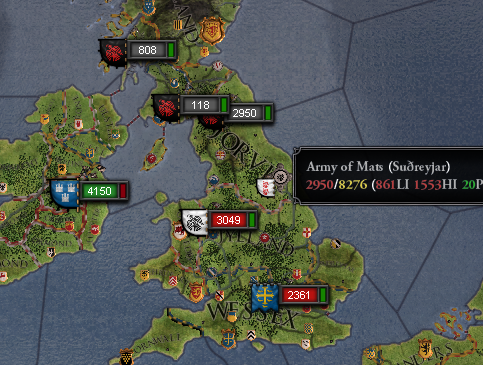 Those two armies to the south, preying on the corpse of Mercia, are Jorvik and Wessex respectively. It doesn't end well for them, but it's a welcome distraction to Ivar, who if left unopposed will happily crown himself King of Scotland.
Those two armies to the south, preying on the corpse of Mercia, are Jorvik and Wessex respectively. It doesn't end well for them, but it's a welcome distraction to Ivar, who if left unopposed will happily crown himself King of Scotland.On 22nd March, 872, Aed of Dublin demanded his independence from King Ivar the Boneless and invaded Inse Gall. The messenger sent returned in three pieces, and all communication ceased between the two. Since the mercenary army outnumbered the defenders of the castle of Finlaggen nearly ten to one, Aed ordered a full assault on the castle, which fell within a fortnight. The Temple of Iona followed suit soon after, by which time Ivar's full army had returned to Inse Gall to address the rebel insurgency. Aed arrived in person via longship to deal with the threat, only for Ivar to pull his forces back in an attempt to rejoin them with a smaller force of five hundred in Argyll rather than face the undesirable conditions of a crossing to Inse Gall. Aed was forced to redeploy his forces to a less desirable position.
 Not Pictured: Ivar's extreme indecision complex.
Not Pictured: Ivar's extreme indecision complex.However, as soon as he reboarded his longships, Ivar returned to try and retake Inse Gall. Taking inspiration from his enemy's choices, Aed decided to try upon a feint instead; he concealed his longships in coves throughout the islands, pretending to have returned to Ireland to raid once more. The feint succeeded and Ivar's men arrived at the shores of Iona in time to be assaulted by nearly a thousand archers from the rocks above. The initial barrage was successful in breaking Ivar's weaker right flank, who fled almost immediately. The strategy only started to come apart when melee was joined and the decidedly slothful Irish mercenary commander hesitated instead of joining the attack, leaving the Scots main body to face a devastating berserker charge to the flank from the Boneless' huscarls. Mercifully the main Sudreyar column broke, leaving Ivar's own flank to be dealt with alone.
 Victory is assured!
Victory is assured!Or so they thought. Half way through the battle, reinforcements landed on Ivar's side, bringing the fight back to full urgency and giving Ivan's berserkers another chance to avoid direct confrontation. The resurging flank was too much and the column broke under the pressure, leaving the unprepared Irish mercenaries to face the Boneless alone. The weaker Irish flank, mostly consisting of archers and light infantry, was unable to stand up to the Sudreyar attack and broke first against Ivar's superior leadership and arms. The grand army of Dublin was chased from Inse Gall like a pack of dogs.
 Victory is- damn it.
Victory is- damn it.Although Ivar won the battle of Iona, his victory was a Pyhrric one. Most of his army had been comprised of adventurers remaining from his invasions of Lothian and East Anglia. His actual levy was relatively weak, and unlike the mercenary army of the Dubliners his men could not easily be replaced. Humiliating as the defeat was, it could still play into Aed's hands for as long as he could continue to afford his army.
Ivar did not pursue the Dubliner army, instead opting to free his occupied holdings in Inse Gall. Aed therefore took the opportunity to carouse through the rest of Scotland, torching Sudreyar holdings wherever he found them. The two armies did not engage in battle again until February 873, where they met on the field at Edinburgh. Fortunately for the mercenaries and their largely lightly equipped army, they were able to whittle down much of the Sudreyan force through skirmishing and bowshot before the main battle was joined. when the melee began, the Dubliner force had a two-to-one advantage and were able to combine a fierce Scots melee charge with co-ordinated volleys from the Irish archers.
The attack managed to utterly crush Ivar's forces before the king could respond with one of his devastating berserker charges, resulting in the first clear victory for Aed in the war. The success at Edinburgh went a good way toward wiping out the shame of the earlier loss at Iona and building up Aed's reputation as a warlord.

The Dubliner army pursued the remnants of the Sudreyan army to Dunbar where Sygtrygg Ivarsson, heir to the throne of Sudreyar and Ivar's son (appropriately), was captured. This, combined with Aed's return to Inse Gall and the repeated sacking of Ivar's capital, was enough to broker a peace. In exchange for the return of his son, Ivar acknowledged Aed's independence and the freedom of the Dubliners as a people. As of the 17th August 873, Dublin was a free county.
 Nothing ends a war better than capturing the opponent's son, save capturing the opponent proper. Just a shame we couldn't save him for the Blot.Chapter Three: Aggressive Expansion
Nothing ends a war better than capturing the opponent's son, save capturing the opponent proper. Just a shame we couldn't save him for the Blot.Chapter Three: Aggressive ExpansionAed celebrated the success of his war in the traditional way; by sleeping with someone other than his wife. Having been four years since Eua was born, Aed had begun to have serious doubts about his attractive young wife's fertility. Aed desperately desired a son to carry on his reign, and a rather bright young woman by the name of Gyda had come to his attention in a foreign court. He arranged to take her on as a concubine, at least until she produced him a suitable heir. Lairsifona's opinions on the matter are not recorded, but given concubinage was considered acceptable at the time she presumably at least put up with the other woman if she did not welcome her.
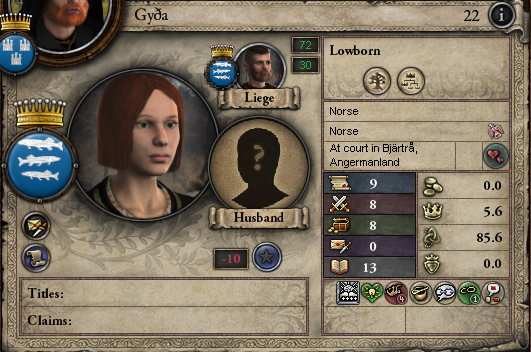 Lazy, overly chatty and actually half-celibate. Aed sure knows how to pick 'em.
Lazy, overly chatty and actually half-celibate. Aed sure knows how to pick 'em.On completion of his war of independence, Aed still possessed nearly a hundred pounds of silver in his treasury, enough to keep his mercenaries in pay for at least another year. Not one to waste an opportunity, Aed immediately began the process of expanding his demesne and, not coincidentally, putting paid to the influx of Catholicism on the Emerald Isle. He declared war on the boy-Earl Cinaed of Leinster in January 874 and met their armies in the field at Ferns soon after. The battle was clearly one-sided and made besieging the castle of Leighlin that much easier. Sieges stretched out the war for the remainder of the year, but the Earl's surrender was accepted by year's end.

Not one to rest on his laurels (and keenly aware of the limitations of his hoard), Aed immediately declared war on the Earl of Ormond. The current Earl, Dub-da-Crich, had only recently ascended to the throne by virtue of forcibly removing the previous occupant. As a claimant of the throne, he had raised an army of adventurers and returned to seize it by force, ousting the former Earl. The remnants of his army remained, which amongst other things meant that Aed's men would actually have to fight a real battle. The armies met at Waterford in Ormond, but the mercenary army had a numerical advantage and vastly more archers, allowing them to gain a crucial early advantage in the battle.

Or at least, one would assume. A series of tactical blunders by the mercenary captains resulted in an astounding loss on the part of Dublin, one that would take expensive months to recover. A second battle would eventually be won at Wexford in May, one led by Aed himself to ensure victory.
September 875 would see the birth of Aed's son, Aed, through his concubine Gyda. Although not as brilliant as Aed had hoped for, young Aed was at least male and not deformed, which was suitable enough for his father's purposes. To avoid risking the succession with further male heirs, however, Gyda was immediately put aside from her concubinage duties and abandoned with a small pension.
[Avoiding a dispute of succession is very, very important as a pagan. Pagans are restricted to gavelkind succession, arguably the most frustrating if not the worst succession form - while on the one hand you can manage expanded territory, on the other hand your lands are carved up piecemeal upon your death between all legitimate heirs. The best way to avoid this? Only have one legitimate heir.]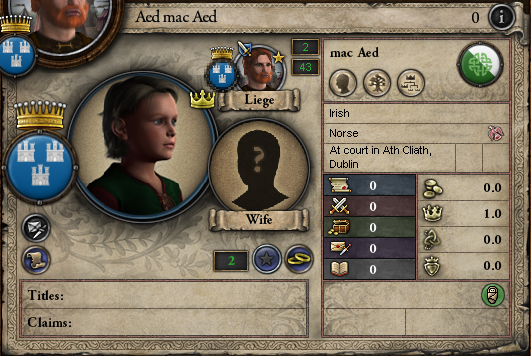 A potentially disappointing heir, but at least he isn't a hunchback. Education might do well for him, though.
A potentially disappointing heir, but at least he isn't a hunchback. Education might do well for him, though.876 continued quietly for Aed, mostly consisting of besieging Ormond, however on no less than four occasions did he receive correspondence from his spymistress, currently resident in Miklagard, offering information on the various advancements of the Byzantines. With her help, Aed was able to accurately plan for improvements in the development of Ath Cliath and Dublin, as well as laying down a formal code of law by which disputes were judged. New metalworking techniques for the production of chainmail were implemented and the first reforms in the organisation of Aed's personal guard and huscarls was seen, giving rise to what would eventually be a professional personal regiment for the king.
Ormond finally fell toward the end of 876, at which point Aed faced a choice as to whether to continue the use of mercenaries in his rampage. Although the sack of Ormond had restored some of his treasury, the continual drain on his hoard was a source of some dread. Perhaps fortunately, his enemies had thinned out the numbers of the sellswords, limiting the amount he had to pay, but the threat of a mercenary invasion still loomed if he got caught out. For now, Aed decided to continue but use his loyal retainers to loot neighbouring provinces on the side. He therefore declared war on Thomond as well. This war proved short and uneventful, ending in February 877 with Aed now controlling a significant portion of the Emerald Isle.

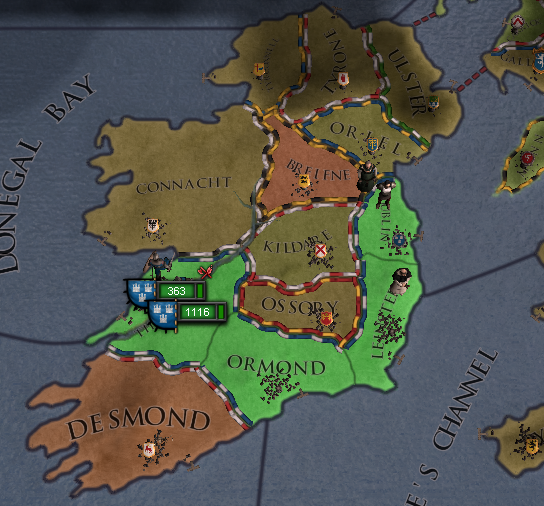 A reasonable claim, if not wholly accurate. Note that all of Aed's personal holdings are coastal. Shipyards are very worthwhile, and eventually we might have a vassal build trade posts upon them, increasing their value significantly.
A reasonable claim, if not wholly accurate. Note that all of Aed's personal holdings are coastal. Shipyards are very worthwhile, and eventually we might have a vassal build trade posts upon them, increasing their value significantly.877 and 878 saw a temporary halt to Aed's expansion as he returned to his Viking roots and once again began accruing large amounts of wealth from his immediate neighbours. He spent a certain amount of this time bringing his two children with him, particularly the rather adventurous young Eua who would often climb high buildings and trees. A local skald composed a saga about Aed's rise to power and throwing off the shackles of King Ivar, pleasing Aed greatly and improving his standing - if somewhat expanding his boastfulness as well.
 The mac Aed family chronicles largely consist of violence and daredevil parkour. Much like that of the Auditores.
The mac Aed family chronicles largely consist of violence and daredevil parkour. Much like that of the Auditores.In 879, following a lengthy raid of the continent, Aed returned to Dublin with holds full of Francian cloth and glassware, steel, silver and thralls. He immediately began spending it like water, hiring craftsmen to improve his throne room in the palace at Ath Cliath and purchasing exotic and extravagant gifts for his vassals and bondsmen. As winter drew to a close, he summoned his most important subjects and emissaries from the surrounding kingdoms to Ath Cliath and there declared himself king, not merely of Dublin, but of all the south of Ireland. Flattered by gifts and impressed by his power, his claim was acknowledged by enough to become fact.
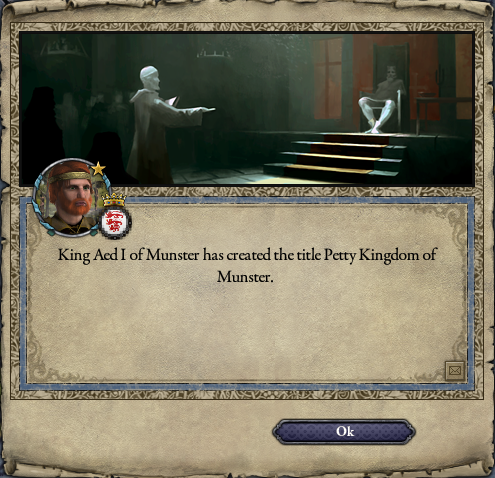
In celebration, Aed laid waste to the earldom of Desmond. The scouring took the better part of a year, but produced two very desireable outcomes; first, the capture of the Earl of Desmond's son - quite apart from his value as a hostage, young Cennetig had the potential to fulfil Aed's dreams of piety. Second, Aed came upon an axe of a strange design, marked with the same knot symbol in the chest he had taken from Knockaulin ten years before and made of the same strange metal. Aed found the new axe to be lighter and sharper than the fine steel one he had been used to, so he took it up as his own blade and carried it with him until the day he eventually died, when it was buried with him in his barrow.
Following the sack, one of Aed's old retainers, Thorsteinn, came to his king to pay final homage. He announced his intention to leave the court in search of a realm of his own, having gathered together a band of adventurers who sought glory as he did. Aed gave his blessing and Thorsteinn departed on his way. Aed would later learn that Thorsteinn had taken his host to the African coast and attempted to carve out a holding in Algers. He had been unsuccessful and was imprisoned by the local Emir. Thorsteinn was eventually banished and retreated to the isle of Mann, where he raised a runestone in testament to his failure.
[Although you can potentially get more money more quickly by moving around and only looting the 'cream' of provinces (the unguarded wealth), sacking holdings is the only way to prompt events like the +2 axe.
Oh, and Thorsteinn absolutely raised a runestone. I think he did it while commander of his 'host', but I felt it worked better as a sort of eternal mark of shame rather than hubris.]
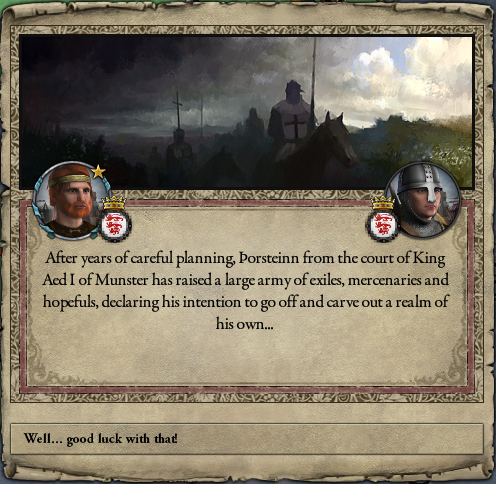 Luck didn't serve him, which is a shame because a Norse Algiers would have been fantastic.
Luck didn't serve him, which is a shame because a Norse Algiers would have been fantastic.Aed could not remain content for long with the south of Ireland alone. In 880 he began a campaign to unify the landlocked heartlands of the Emerald Isle under his blood-stained banner. A brief battle at Gowrie put paid to the armies of Ossory, who surrendered in mid-881. Aed actually spent a year razing the holdings of the Earl of Kildare to the ground before declaring war and laying siege to the ruins. Aed took the heirs of the Earl captive in the siege, bringing the total of infant prisoners in the dungeons of Ath Cliath to three, though the boy was released when Earl Kildare surrendered.
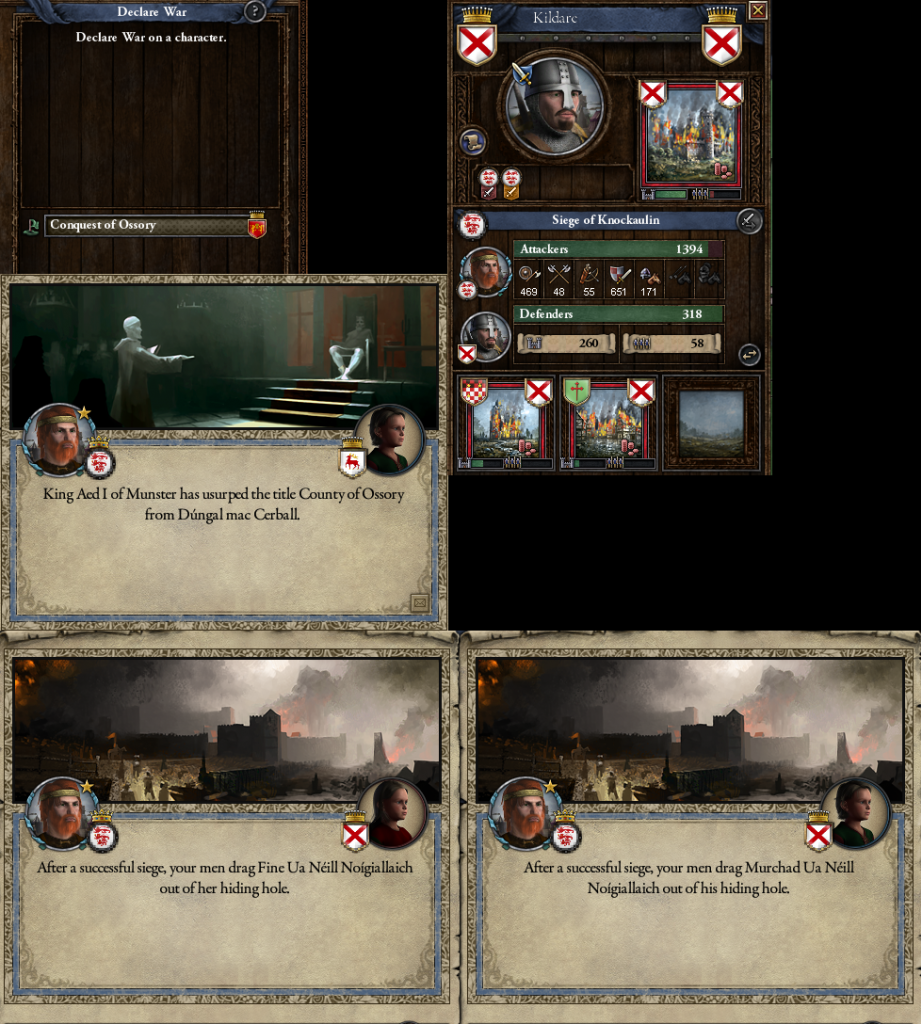 These children will live long, productive and free lives.
These children will live long, productive and free lives.Perhaps due to Aed's apparent mercy, but more likely due to his efforts to purge Catholicism from the land (Leinster had already taken up the cults of Thor and Freyr in preference to the Pope and his Dead God) Aed became known as something of a paragon of virtue among Irish Norsemen; brave, pious and utterly ruthless to the God-worshippers.
Alarmingly, he also proved decidedly fertile. The supposedly barren Queen Lairsifona announced her pregnancy in later 884, pleasing and alarming the King at once. The appearance of a second male heir could ruin his plans.
Aed's first child, Eua, came of age in 885. Like her father she had been a keen student of the skalds and possessed a deep and abiding love both for the sagas and the natural world. Eua nic Aed mac Aed was responsible for pushing many of the technological reforms in Dublin, including the expansion and development of Ath Cliath and the implementation of new fortifications and an expanded shipyard.
Eua was swiftly wedded to a new arrival at court, a much older Norseman by the name of Gandalfr who had displayed a prodigious talent for diplomacy. He possessed great strength and virility for his advanced age, and his marriage to Eua was most likely a design on Aed's part to create a powerful cadet branch of the family to serve his male heirs.
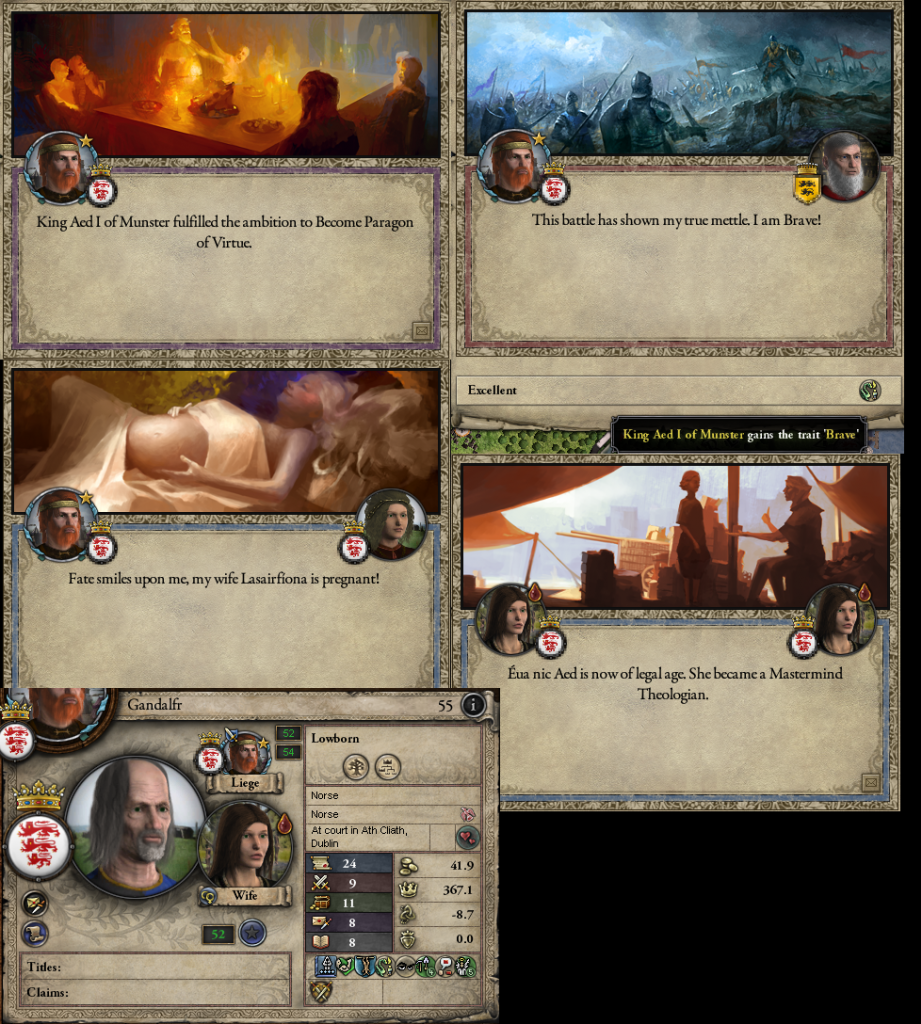 Sure he's 39 years your senior, but they say he's hung like a horse!
Sure he's 39 years your senior, but they say he's hung like a horse!Aed went on to sack Briefne, capturing the Countess and one of the Earl's lackeys. He ransomed the lackey (but not the Countess) at the end of the year in exchange for the county, completing his dominion of the inner island. To Aed's great relief, Lairsifona gave birth to a healthy baby girl and not a succession threat as Aed had feared. Pleased by the prospect of another safe cadet branch, Aed welcomed young Dervorgilla with open arms and a warm heart.
With the conquest of central island complete, Aed once again expended much of his treasury on gifts and honours, declaring himself Jarl of Tara and the middle counties.
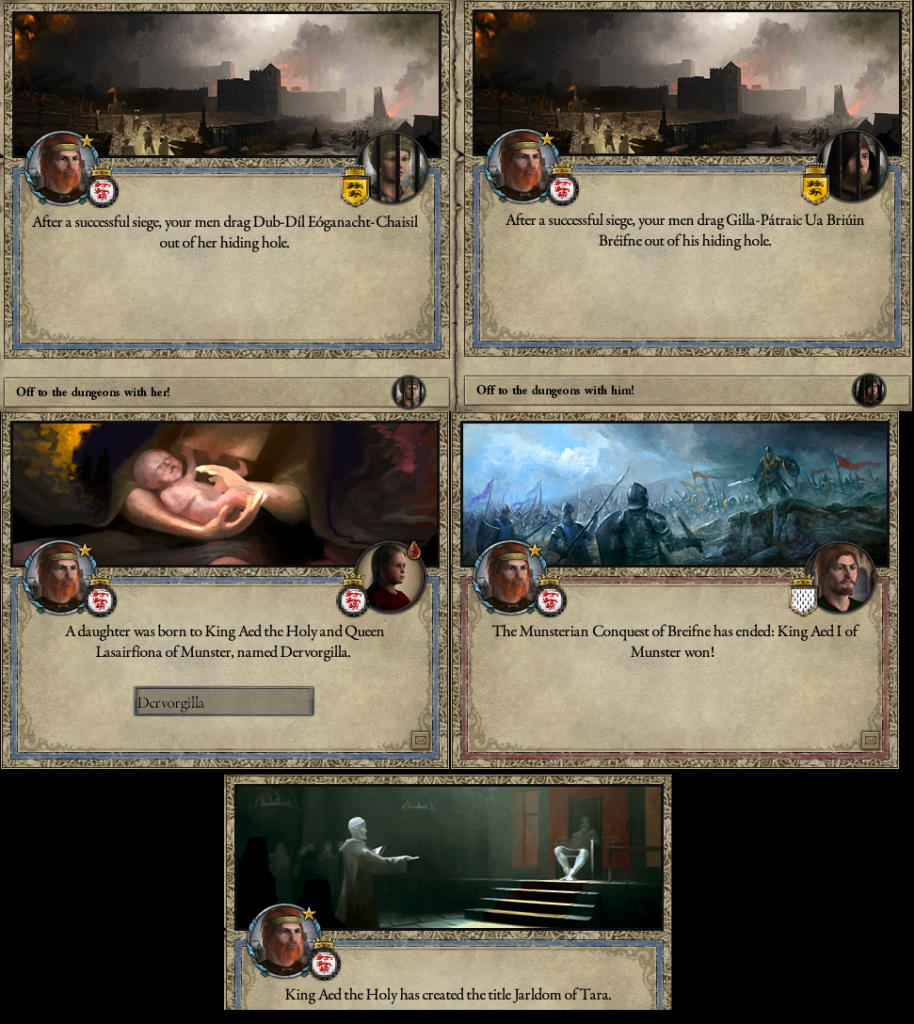
King Aed, desiring further gold and glory and sated for the moment with territorial conquest, began questing out further and further abroad with raiding parties larger than he had ever before attempted to employ. After another year at sea, Aed returned in January 887 with a fleet full of treasure. Yet again, Aed summoned his vassals and neighbours to Ath Cliath for feasting and gifts.
This time, there was more than a petty kingdom at stake. The longhall at Ath Cliath had been expanded, with new walls of stone and decked out with stolen statues and artwork from the Franks. Several holy oaks had been planted in a grove around the hall, with one enormous oak uprooted and replanted with great care in the central court, spaces saved around it for runestones and sacrifices. The simple wooden chair of the Jarl had been replaced with a granite throne, draped in rich tapestries, and when Aed greeted his people he did not do so in his mail but in a robe of stolen Frisian silk cut with ermine and a crown of bronze and gold set with a single looted sapphire the size of a man's thumb.
By the grace of the Thunderer and the wisdom of Odin, Aed proclaimed himself King of the Emerald Isle, and none dared refute his claim.
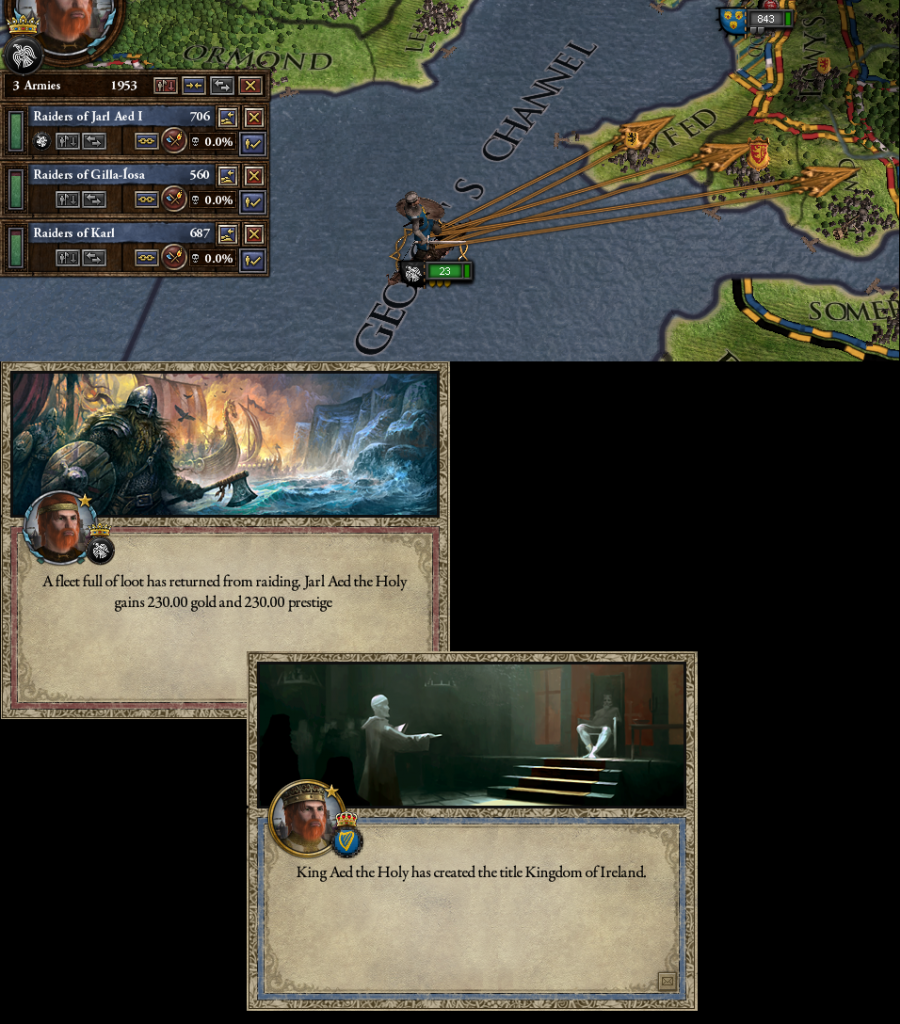 It's good to be king.
It's good to be king.

 Author
Topic: Let's Play CK2: The Vikings of Ireland (Read 21299 times)
Author
Topic: Let's Play CK2: The Vikings of Ireland (Read 21299 times)
